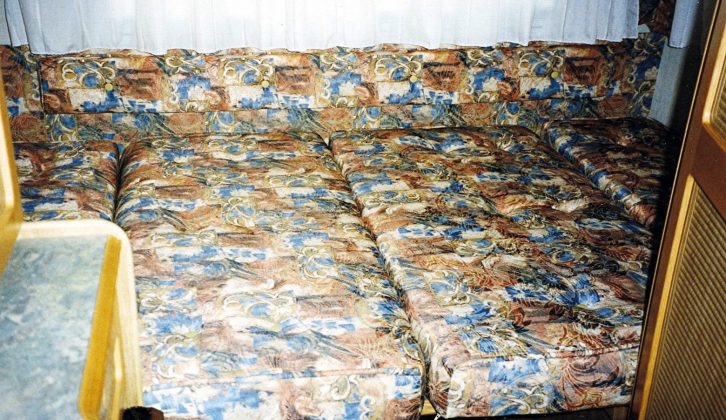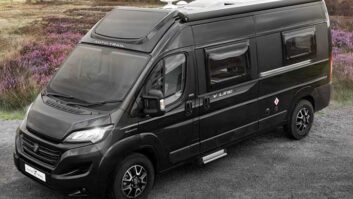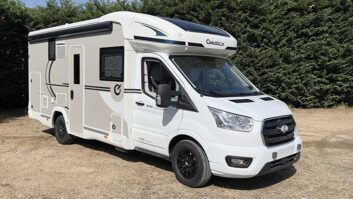The invasion of Italian motorhomes began in the early 1990s and went on until the mid-noughties when a dip in the euro exchange rate caused a lull in imports. The influx was spearheaded and nurtured by concessionaire Don Amott Leisure and to a lesser extent by Madisons of Preston (aka Hymer UK).
The mighty CI operation in Florence was then the European leader in producing value-for-money coachbuilt motorhomes. Don Amott persuaded them to build right-hand drives.
The CI Granduca Pegaso 63N and 62 were designed as 6.6m family motorhomes, but they were also favoured by couples wanting room to spread. Both models offered six dedicated travel seats and six berths; the most popular was the Granduca Pegaso 63N, which offered a layout that mirrored the Swift Kon-Tiki 640 and the Auto-Trail Scout.
They featured a forward Pullman dinette opposite a galley kitchen, a washroom and wardrobe amidships, plus a rear U-shaped triple-aspect lounge. In the Granduca Pegaso 62, the central washroom was replaced with a longitudinal one in the far nearside corner, alongside an additional dinette in the offside rear corner. The latter could be made into an inward-facing settee for feet-up relaxation.
Equipment levels were high and even with 100 litres of fresh water aboard there remained 550kg of payload on its 3500kg chassis. What came as a surprise to UK buyers was just how advanced CI washrooms were. They were the first budget imports to feature wipe-clean ABS plastic-clad washroom walls and integrated moulded cabinetwork. They were also spacious, so found favour with young families where children might need mum or dad to assist with ablutions.
The CI Granduca Pegaso benefitted from clever design features. A full-width rear-boot (in the Pegaso 63N), feature doors with contrasting inserts on cabinetwork, bright ‘summery’ soft furnishings and duo-tone external coachwork all helped to suggest that these newbies had more in common with the sunny Italian Riviera than with a wet weekend in a UK seaside resort.
Sofim’s (then) class-leading 2.5-litre turbo diesel engine powered them along with ease, while their Maxi chassis offered bigger wheels and tyres and heavier-duty suspension.
Both CI Granduca Pegaso models are highly desirable as a pre-owned purchase. Interestingly, current CI offerings are badged Roller Team, with Auto Roller and T-Line ranges (see our 2015 T-Line 590 video and review).
What to look out for
This generation of Fiat Ducato had a habit of dropping fifth gear. It’s not an expensive repair; the ’van can still be driven and the gearbox doesn’t have to be removed. Back in the day it was suggested that the fifth gear failed because it was only splash lubricated, though we think it was an original manufacturing weakness because once replaced, they rarely fail again, even after covering inter-galactic mileages. Apart from this, Ducatos are good and were very advanced at their launch.
Pegaso models were the least likely CI coachbuilts to leak but, as with any coachbuilt of this era, check carefully for signs of water ingress. The eldest will be 20 years old now, so budget for equipment updates and insist on a full habitation service before purchase.
Likes and dislikes
So, to summarise, what do we like – and dislike – most about the 1995-2000 CI Granduca Pegaso 63N and 62 six-berth motorhomes?
Likes:
- Practical, easy-to-live-in layouts
- Surefooted and powerful
- Proper (adult) six-berth accommodation
- Summery interior vibe
Dislikes:
- Cab seats are not trimmed to match residential seats on the early models
- No (standard) 230V operation of water and space heating
Buying essentials
The CI Granduca Pegaso 63N and 62 motorhomes were built on long wheelbase Fiat Ducato Maxi chassis-cab ‘vans, from 1995-2000, in Val D’Elsa, Florence, Italy. These six-berth overcab coachbuilt motorhomes were 6.6m (21’ 7.75”) overall.
Which would we choose? Taking all factors into consideration, we’d choose either version of the layout. The Pegaso 62 offers a cracking floorplan but most folk back then wanted a Kon-Tiki/Scout lookalike, so it didn’t sell as well as the Pegaso 63N. Later models had trimmed cab seats with swivels, but I don’t think their absence on earlier models will be a deal-breaker.
Talking of deals, how much should you look to pay for a CI Granduca Pegaso? Early examples cost from £12,500 if you buy them from a private seller. Later versions might cost up to £22,950 from a dealer, with full warranty.
As a guide, a dealer has just sold a one-previous-owner 2000 Pegaso 63N with just 26,000 miles covered. The asking price was £15,500.
Alternatively you could buy the badge-engineered lookalikes, which are the CI Riviera 171 and 181. And as a bonus these remained in production until 2005. The flagship CI Mizar is also worth considering, but is much rarer to find.
Pegaso models were the least likely CI coachbuilts to leak

















